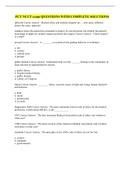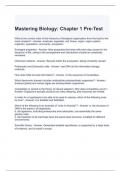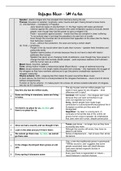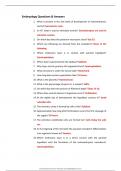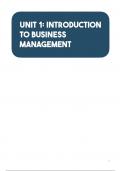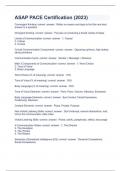& CORRECT ANSWERS
Define angina? - ANS-§ Stable, predictable exertional pain.
§ Doesn't increase in frequency or severity over time.
§ Generally caused by fixed obstructive atheromatous lesion.
§ Resolves with rest and treatment
§ May be preventable with pretreatment
Define unstable angina - ANS-§ Thrombus partially or intermittently occludes the coronary artery.
§ S/S:
· Pain with or without radiation to arm, neck, back or epigastric region.
· SOB
· Diaphoresis, N, lightheadedness
· Tachycardia, tachypnea, hypotension or hypertension.
· Decreased SaO2 and rhythm abnormalities
§ Because it is caused by a more significant narrowing of the coronary artery vessel, the symptoms are
generally more pronounced and:
· Increasing with frequency
· Occurs with less provocation
· Are less likely to be resolved with treatment
· May occur at rest-HALLMARK SIGN
· Requires prompt evaluation/treatment
S/S for unstable angina? - ANS-· Pain with or without radiation to arm, neck, back or epigastric region.
· SOB
· Diaphoresis, N, lightheadedness
· Tachycardia, tachypnea, hypotension or hypertension.
· Decreased SaO2 and rhythm abnormalities
§ Because it is caused by a more significant narrowing of the coronary artery vessel, the symptoms are
generally more pronounced and:
· Increasing with frequency
· Occurs with less provocation
· Are less likely to be resolved with treatment
· May occur at rest-HALLMARK SIGN
· Requires prompt evaluation/treatment
Define an NSTEMI - ANS-§ Cause:
· Thrombus partially or intermittently occludes the coronary artery.
§ S/S:
,· Very similar to unstable angina, pain may be more substantial, more difficult to resolve.
§ Major difference:
· Cardiac markers (enzymes) elevate to indicate muscle damage.
· No ST segment elevation
· ST depression, T wave inversion
define a STEMI - ANS-§ Cause:
· Thrombus fully occludes the coronary artery, ST elevation
§ S/S:
· Again very similar to angina, unstable angina, but generally more severe and generally unrelieved with
basic treatment (O2, nitro, rest)
What are treatment priorities for the patient that presents with ACS? - ANS-§ Pain control
§ Pain assessment- OLC CARTS
§ Nitro- check bp first before administering
§ ASA- platelet aggregation
§ O2 supplementation
§ Morphine (second potential for pain, continuing pain after nitro
§ Ultimate goal is zero pain.
§ Lead a 12 lead EKG, cardiac enzymes (troponin),
§ thrombolytics or Cath lab, get those vessels open!
Describe administration of nitro SL for acute chest pain, what is its action? - ANS-o Causes vasodilation
of coronary vessels
o Can drop BP precipitously, so taking BP before each dose is essential
o One nitro SL q 5 min x 3 if pain continues. If remains after 3 doses, MUST call 911.
o May start on Nitro infusion to more gently control pain and sustain BP.
What are three complications post PCI and their emergent treatments? - ANS-o Hematoma at the site-
direct pressure, should be some firmness
o Bleeding-direct pressure
o Pseudoaneurysm (femoral)- may heart a bruey and may here a thrill
o Retroperitoneal bleed (flank pain) if you miss flank pain you will see hypotension, tachycardia, possible
bleeding
o Stroke
What is the main action of a thrombolytic in a STEMI - ANS-o Dissolve clot in the coronary vessels
o To limit the size of the MI and get more blood flow
What is 1st degree burn? - ANS-§ Usually skin is in tact
§ The nonvascular outer layer of the skin and is a thick as a sheet of paper.
§ The epidermis is a protective barrier for the skin, holding in fluids and electrolytes and aiding in body
temperature regulation.
What is 2nd degree burn? - ANS-§ Caused by chemicals, flame, or hot liquids damage the epidermis and
part of the dermis.
§ A lot more pain you have reached nerves
, § These second-degree burns appear as fluid-filled vesicles that are red and shiny (and wet if the vesicles
have ruptured).
§ Healing typically takes 10-21 days for superficial partial thickness burns, which involve part of the
dermis, and 2-6 weeks for deep partial-thickness burns, which involve more of the dermis.
§ Symptoms include:
· Include edema, Hyperesthesia, pain cause by nerve injury, and sensitivity to cold air.
What is 3rd degree burn? - ANS-§ May extend to the subcutaneous tissue, meaning the skin can't heal
on its own.
§ Caused by prolonged exposure to chemicals, electrical current, flame, hot liquids, or tar.
§ Skin appears dry, waxy, white, leathery, or hard.
§ Thrombosed vessels will be visible, and muscles, tendons, and bones may be involved.
§ S/S:
· Lack of pain
· Possible hematoma
· Possible entrance and exit wounds
· Shock
· Skin grafting is often required.
What is the mechanism in burns by which the burn patient has a significant fluid volume deficit? - ANS-§
Increased capillary permeability
§ Inflammatory response, histamine release
§ Loss of heat:
What type of fluid is used in resuscitation for burns and why? - ANS-o Lactated Ringers bc its closer to
plasma and helps buffer acidosis
What are symptoms might a patient to lead to suspicion of an inhalation injury? - ANS-o Facial injury
o Facial edema
o Loss of facial hair
o Soot from ashes
o Look for Carbon Monoxide poisoning
o Singed hair
o Hoarse voice
o Wheezes
What are initial nursing priorities in caring for a patient with significant burns? - ANS-o Airway
o Breathing
o circulation
o Pain control
o Temperature control
o Continuously assess
o IV access ASAP
Identify the common ventilator settings? - ANS-§ FiO2: % of oxygen (above 21-100)
§ Rate: how many breaths per minute delivered by vent.
§ Tidal Volume: how many mLs per breath.
§ Mode: pattern of ventilation delivery by the vent



